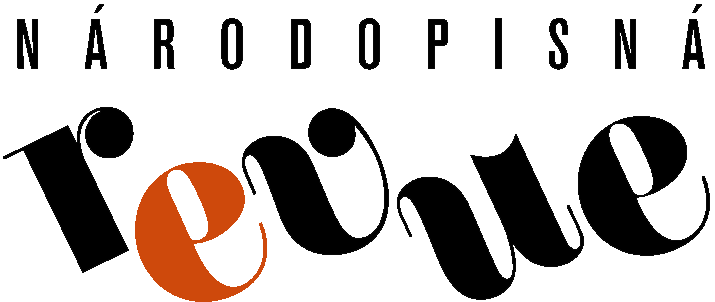Journal of Ethnology 3/2020 focusses on the contemporary countryside. Přemysl Mácha deals with multi-cultural coexistence in the Těšín area, mainly from linguistic perspective (Bilingual Signs in the Těšín Area, or the Těšín Countryside as an Experiment with Plurality). Juraj Janto pays attention to the study of Slovak rural localities near large cities in the second half of the 20th century (Rural Localities in the Hinterland of Large Cities in Slovakia: from the research on suburban municipalities near Bratislava). Katarína Koštialová deals with the importance of the folklore festival in the Slovak village of Hrušov in relation to the particular locality and its inhabitants (The Hont Parade Festival – a Positive Example of the Marginalised Village of Hrušov). Margita Jágerová analyses cultural and social activities in selected villages in Slovakia (Inspirational Sources of Cultural and Social Events and Celebrations in Current Rural Environment / on the example of the villages of Vlachovo, Soblahov, Malé Dvorníky, and Liptovská Teplička). The text by Martin Novotný about rural architecture and the role of untrained artisans (Untrained Artisans /called autodidacts/ as Bearers of Traditional Techniques (with regard to building tradition in the lowland-house area in Moravia and Slovakia) has been included out of the theme.
The Transforming Tradition column publishes a text by Marta Ulrychová about the history of the Postřekov Folk Ensemble, one of the oldest Czech folk ensembles. In Review Section, Martina Pavlicová commemorates the 100th anniversary of the birth of the Moravian ethnochoreologist Zdenka Jelínková (1920– 2005), and Oldřich Kašpar remembers 125 years since the birth of the Ibero-Americanist and linguist Čestmír Loukotka (1895–1966). Interview Section is dedicated to the life anniversary of Věra Kapeller, a Czech ethnologist living and working in Austria (born 1950). Social Chronicle remembers the jubilees of the folklorists Milan Leščák (born 1940) and Marta Šrámková (born 1935), and it publishes an obituary for the ethnologist Renata Zemanová (1927–2020). Further regular columns include reports on conferences and festivals, and reviews of specialized literature.
Bilingual Signs in the Těšín Region or the Těšín Countryside as an Experiment with Plurality
The article focuses on conflicts in the Těšín countryside which have arisen in the last fifteen years in reaction to the introduction of bilingual, Czech-Polish signs. The topic is analyzed in the context of the politics of toponymy and debates about integration models in multi-cultural societies. The text offers a brief summary of selected research findings based on the analysis of linguistic landscape, media discourse, and opinion of local inhabitants, municipal representatives and members of Polish organizations obtained through interviews and questionnaires. The research showed that bilingual signs played an important role in Czech-Polish relations in the Těšín region. Although the media supported the introduction of bilingual signs, most people declaring Czech nationality opposed them even after more than a decade of their presence. Most commonly, opponents emphasized the need for the Polish minority to assimilate into the Czech majority society. Attempts of Polish minority to introduce bilingual signs have failed in many municipalities while in others they have succeeded only partially. Only a handful of municipalities introduced bilingual signs beyond their legal requirements, opening thus doors to a genuine multicultural community.
Rural Localities in the Hinterland of Large Cities in Slovakia: from the research on suburban municipalities near Bratislava
The so-called hinterlands of cities constitute one of the important categories of rural localities; these are municipalities that are connected with a nearby city through employment and other activities of their inhabitants. Many of them are part of the suburbanization process with growing residential housing and growing population tied to the urban settlement. The process of (modern) suburbanization in Slovakia appeared in the second half of the 1990s, most markedly near Bratislava and in the vicinity of other larger cities. This category of municipalities is growing in size and number and it is thus becoming an increasingly important phenomenon of rural (or rural-urban) settlement. Qualitative (ethnographic) research on these villages in Slovakia is still in its infancy. In our research on two localities near Bratislava we focused on finding out the level and form of relations between local old inhabitants and new settlers. We also noticed the motivation of new residents to move to the village. We obtained data from the declared statements of informants in an ethnographic interview. Their analysis showed that contacts between the two groups occur randomly and sporadically, and their form is formal and courtesy. The most frequent factors for moving into the village were the price of the house, the desire to live in a “green” and peaceful rural environment, and the feeling of privacy and freedom.
The Hont Parade Festival – a Positive Example of the Marginalised Village of Hrušov
The study, which is result of the ethnological research conducted periodically since 2017, identifies factors which entered the process of the successful establishment of the Hont Parade Festival in Hrušov (Slovakia). At the same time, it demonstrates to what extent the festival has influenced the village and its citizens. In addition, the study outlines potential threats related to the locality and festival. Hrušov (the 2013 winner of the Village of the Year award) lies in a marginalised locality, which on one hand devalues the local community; on the other hand it motivates the local community towards social cohesion and cooperation. It appears that it is local citizens, community, exceptional leaders and generational coexistence, as well as intergenerational transmission of cultural values that constitute essential factors of the resilience against unfavourable determinants. All the above-mentioned aspects can be considered to be main determinants in establishing and sustaining the festival of national importance. The festival presents a particular form of local community representation, it is a marketing tool, and it is involved in creating the image and brand of the village and region. Simultaneously, it is an important factor of the change which leads to the openness to the benefit of the village and its inhabitants. The festival brings some negative points, the main ones being the strain on the village environment and the decreasing number of inhabitants.
Inspirational Sources of Cultural and Social Events and Celebrations in Current Rural Environment (on the example of the villages of Vlachovo, Soblahov, Malé Dvorníky, and Liptovská Teplička)
The study provides a comparative analysis of current forms of the all-year-round cultural and social festivities on the example of four selected villages. It tries to define the basic sources of inspiration for these events, the factors influencing this sphere, and it also seeks identical and different elements in this area and the possibility of using the “societal capital” (human, social and cultural) of each municipality in these activities. The basic source of inspiration for most socio-cultural events includes the local folk culture with the traditional annual cycle being the main part of it; in several cases, the annual cycle is tied to church holidays. In recent decades, events dedicated to children, or more precisely families with children, mothers and pensioners have become a kind of "cultural and social constants" not only in the rural but also in the urban environment. The research confirmed the residents' lack of interest in celebrating the state and political events. Especially in suburban areas, the import of new globalized phenomena is more evident, whereby the more isolated villages have better conditions to develop their local traditional culture. The article presents several findings regarding the “societal” capital, especially the unequal use of human and cultural capital in the monitored villages, and it also emphasizes the importance of residents’ activism and support to this area by local governments, and the creation of the best possible conditions for cultural background and infrastructure.
Autodidacts as Bearers of Traditional Techniques (with regard to building tradition in the lowland-house area in Moravia and Slovakia)
The essay explains the background for rural buildings in the territory of former Czechoslovakia (Moravia, Slovakia). This concerns mainly the period beginning with the second half of the 19th century until the 1980s. The theme is infrequent in ethnology, which is also confirmed by the amount of relevant literature. The text takes into account the production of building elements and the portion of self-help (the participation of family members and neighbours in civil works). The text also outlines the word náturista autodidact, an untrained rural builder and the transformation of its meaning over time. In the case of traditional techniques tied mostly to work with unburnt clay, the essay also mentions the background for their decline, limited performance, and short-lived rebirth in the early second half of the 20th century. The knowledge relating to the maintenance of old earth buildings survived in the researched area until the late 1970s, and it suddenly ceased to exist with the death of the last bearers of this tradition. The essay also pays attention to an interesting phenomenon, meaning the self-help home production of breeze blocks. This phenomenon was typical for rural architecture in Czechoslovakia beginning with the 1960s.



